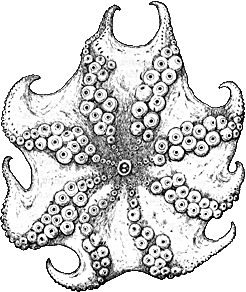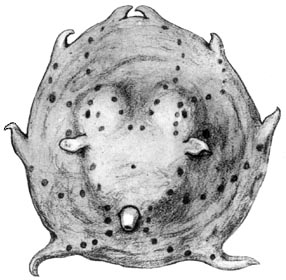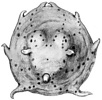Opisthoteuthis depressa
Richard E. Young and Michael VecchioneIntroduction
Opisthoteuthis depressa is known only from waters off Japan. It reaches a size (measured from arm tip to arm tip) of just over 200 mm. Males have a distinctive arrangement of enlarged suckers.
Characteristics


Figure. Oral view of male O. depressa. Drawing from Sasaki, 1929.
- Arms and web
- Arms subequal.
- Web extends nearly to arm tips along dorsal margins of arms but web along ventral margins terminates well proximally.
- Suckers in female: very small, largest ca. 2 mm in diameter; number just over 50 on each arm; suckers uniform size over most of arm, decreasing in size proximally and distally.
- Suckers in males: greatly enlarged and crowded into biserial or triserial arrangement from sucker 5-20; maximum sucker size - 7 mm in diameter in adults.
- First cirri between suckers 1 and 2.
Comments
The above description is taken from Sasaki, 1929. More details of the description of O. depressa can be found here.
O. depressa differs from all members of the genus (where males are known), except O. mero and O. robsoni, in lacking distal fields or at least lacking an increase in sucker size in the distal fields. O. depressa differs from the other two in having more enlarged suckers on each arm of the proximal field (i.e., 16 vs 5-8).
References
Nesis, K. N. 1982/87. Abridged key to the cephalopod mollusks of the world's ocean. 385+ii pp. Light and Food Industry Publishing House, Moscow. (In Russian.). Translated into English by B. S. Levitov, ed. by L. A. Burgess (1987), Cephalopods of the world. T. F. H. Publications, Neptune City, NJ, 351pp.
Sasaki, M. 1929. A monograph of the dibranchiate cephalopods of the Japanese and adjacent waters. Journal of the College of Agriculture, Hokkaido Imperial University, 20(Supplementary number):1-357.
About This Page

University of Hawaii, Honolulu, HI, USA

National Museum of Natural History, Washington, D. C. , USA
Page copyright © 2016 and
 Page: Tree of Life
Opisthoteuthis depressa .
Authored by
Richard E. Young and Michael Vecchione.
The TEXT of this page is licensed under the
Creative Commons Attribution-NonCommercial License - Version 3.0. Note that images and other media
featured on this page are each governed by their own license, and they may or may not be available
for reuse. Click on an image or a media link to access the media data window, which provides the
relevant licensing information. For the general terms and conditions of ToL material reuse and
redistribution, please see the Tree of Life Copyright
Policies.
Page: Tree of Life
Opisthoteuthis depressa .
Authored by
Richard E. Young and Michael Vecchione.
The TEXT of this page is licensed under the
Creative Commons Attribution-NonCommercial License - Version 3.0. Note that images and other media
featured on this page are each governed by their own license, and they may or may not be available
for reuse. Click on an image or a media link to access the media data window, which provides the
relevant licensing information. For the general terms and conditions of ToL material reuse and
redistribution, please see the Tree of Life Copyright
Policies.
- First online 13 May 2003
Citing this page:
Young, Richard E. and Michael Vecchione. 2003. Opisthoteuthis depressa . Version 13 May 2003 (under construction). http://tolweb.org/Opisthoteuthis_depressa/20157/2003.05.13 in The Tree of Life Web Project, http://tolweb.org/








 Go to quick links
Go to quick search
Go to navigation for this section of the ToL site
Go to detailed links for the ToL site
Go to quick links
Go to quick search
Go to navigation for this section of the ToL site
Go to detailed links for the ToL site